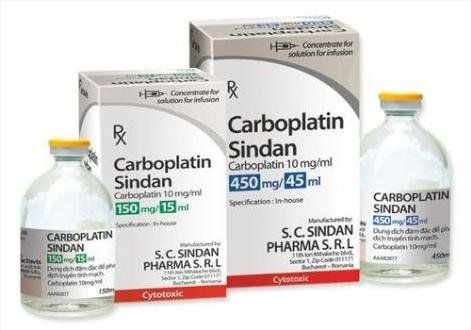This is an automatically translated article.
Amifostine is an anti-cancer drug. The active ingredient Amifostine in the drug helps reduce the accumulation of drug toxicity in the kidneys. In addition, Amifostine also reduces the likelihood of dry mouth caused by radiation therapy in patients with head and neck cancer.
1. Uses of Amifostine
Amifostine belongs to the group of drugs that eliminate the toxicity of cancer drugs, the main ingredient is Amifostine 500mg. Amifostine works to reduce the toxicity of accumulated drugs on the kidneys, especially drugs for the treatment of ovarian cancer (late stage), non-small cell lung cancer. In addition, in patients after radiation therapy for head and neck cancer, Amifostine also reduced moderate to severe dry mouth.
Amifostine is prepared in the form of a powder for intravenous injection and is indicated for use in the following cases:
Reduce the cumulative toxicity of the drug on the kidneys in patients with advanced ovarian cancer. Reducing the incidence of moderate to severe dry mouth caused by radiation therapy in patients with head and neck cancer.
2. How to take and dose of Amifostine
Amifostine is packaged as a sterile lyophilized powder, each vial containing Amifostine 500mg in anhydrous form needs to be reconstituted with 9.7ml of sterile 0.9% sodium chloride solution before intravenous infusion. The infusion and administration of the drug should be carried out by a healthcare professional or a doctor.
Dosage of Amifostine to reduce the cumulative toxicity of drugs in the kidney by chemotherapy: The starting dose is 910mg/m2, intravenous infusion over 15 minutes, conducted 30 minutes before chemotherapy. An infusion over 15 minutes helps the drug to be better tolerated. Before infusion of Amifostine, the patient should be sufficiently hydrated. During the infusion, the patient should be kept in a supine position and blood pressure monitored every 5 minutes. Dosage of Amifostine for dry mouth caused by radiation therapy in patients with head and neck cancer: 200mg/m2, intravenous infusion over 3 minutes, starting 15-30 minutes before radiation therapy. Before infusion, the patient should be adequately hydrated. Before and after infusion, the patient's blood pressure should be monitored. Elderly: Amifostine dosing in the elderly should be used with caution to avoid effects on liver, kidney or heart function. Amifostine overdose occurs in the case of doses up to 2700 mg/m2 in children, when symptoms of anxiety and reversible urinary retention may appear. Usually, overdose causes hypotension and is managed with saline infusion and other supportive treatment.
3. Amifostine side effects
Amifostine can cause some unwanted side effects with the frequency of occurrence as follows:
Very common: Nausea, vomiting, hypotension. Common: Decreased blood calcium levels. Frequency not known: Chills, uncomfortable warm-cold feeling, fever, flushing, drowsiness, dizziness, sneezing, blurred or double vision, hiccups, diarrhea, rash, itching, rash urticaria, bruising, swelling, pain, inflammation at the injection site. If you see any abnormality after injecting Amifostine, the patient should be treated as soon as possible.
4. Some notes when using Amifostine drug
Do not use Amifostine in people with hypersensitivity to the drug's components and aminothiol compounds. Amifostine should be used with caution in people taking medications for high blood pressure because it can cause an increase in blood pressure. Amifostine should not be used in patients with malignant tumors and receiving chemotherapy because the drug may interfere with the anti-tumor activity of cancer drugs, affecting the patient's ability to survive. Amifostine should not be used in patients undergoing definitive radiation therapy because it may interfere with the anti-tumor activity of radiation therapy in cancer. Some serious sequels and hypotension should be noted after taking Amifostine with manifestations such as dyspnoea, apnea, hypoxia, tachycardia or bradycardia, angina pectoris, supraventricular tachycardia, extrasystole , atrial fibrillation or flutter, myocardial infarction, myocardial ischemia, fainting, unconsciousness, convulsions, cardiac arrest, respiratory failure, renal failure. It should be noted that serious and possibly fatal skin reactions in patients after Amifostine treatment such as exfoliative dermatitis, toxic dermatitis, toxic epidermal necrolysis, Stevens-Johnson syndrome, erythema should be noted. diversity. It should be noted that hypersensitivity reactions, anaphylaxis after taking Amifostine include symptoms such as chills, fever, hypoxia, shortness of breath, chest discomfort, itching, skin rash, urticaria, laryngeal edema. During Amifostine infusion, appropriate treatment and epinephrine should be readily available if a serious reaction occurs. At that time, it is necessary for the patient to stop taking the drug immediately and not to use the drug again. After Amifostine infusion, nausea and vomiting are common and severe. Therefore, it is necessary to combine with antiemetic drugs and monitor the patient to balance the fluid. In patients with nephrotic syndrome receiving multiple doses of Amifostine, blood calcium levels should be monitored to avoid the risk of hypocalcemia. In case of need, patients can use calcium pills to supplement. There are limited data on Amifostine in pregnant and lactating women. Therefore, pregnant women are only allowed to use the drug in cases where it is more beneficial, while nursing women who want to take the drug must stop breastfeeding. Although no drug interactions have been recorded, to ensure safety and limit the effects caused by interactions with Amifostine, patients need to provide information about drugs they have been using to their doctor. known, including prescription or non-prescription drugs, herbal products and dietary supplements. The use of Amifostine is to reduce the toxicity of the drug accumulated in the kidneys in the treatment of ovarian cancer and lung cancer. In addition, the drug also reduces the rate of dry mouth in patients with head and neck cancer receiving radiation therapy.
Please dial HOTLINE for more information or register for an appointment HERE. Download MyVinmec app to make appointments faster and to manage your bookings easily.
Reference source: drugs.com












